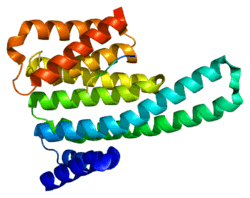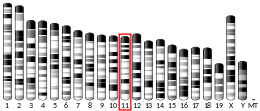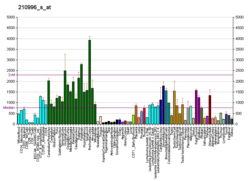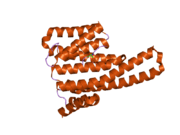YWHAE
14-3-3 protein epsilon is a protein that in humans is encoded by the YWHAE gene.[5]
Function
This gene product belongs to the 14-3-3 family of proteins which mediate signal transduction by binding to phosphoserine-containing proteins. This highly conserved protein family is found in both plants and mammals, and this protein is 100% identical to the mouse ortholog. It interacts with CDC25 phosphatases, RAF1 and IRS1 proteins, suggesting its role in diverse biochemical activities related to signal transduction, such as cell division and regulation of insulin sensitivity. It has also been implicated in the pathogenesis of small cell lung cancer.[6]
Interactions
YWHAE has been shown to interact with:
See also
References
- 1 2 3 ENSG00000108953 GRCh38: Ensembl release 89: ENSG00000274474, ENSG00000108953 - Ensembl, May 2017
- 1 2 3 GRCm38: Ensembl release 89: ENSMUSG00000020849 - Ensembl, May 2017
- ↑ "Human PubMed Reference:".
- ↑ "Mouse PubMed Reference:".
- ↑ Luk SC, Garcia-Barcelo M, Tsui SK, Fung KP, Lee CY, Waye MM (December 1997). "Assignment of the human 14-3-3 epsilon isoform (YWHAE) to human chromosome 17p13 by in situ hybridization". Cytogenet Cell Genet. 78 (2): 105–6. doi:10.1159/000134638. PMID 9371399.
- ↑ "Entrez Gene: YWHAE tyrosine 3-monooxygenase/tryptophan 5-monooxygenase activation protein, epsilon polypeptide".
- 1 2 Conklin DS, Galaktionov K, Beach D (August 1995). "14-3-3 proteins associate with cdc25 phosphatases". Proc. Natl. Acad. Sci. U.S.A. 92 (17): 7892–6. doi:10.1073/pnas.92.17.7892. PMC 41252. PMID 7644510.
- ↑ Vincenz C, Dixit VM (August 1996). "14-3-3 proteins associate with A20 in an isoform-specific manner and function both as chaperone and adapter molecules". J. Biol. Chem. 271 (33): 20029–34. doi:10.1074/jbc.271.33.20029. PMID 8702721.
- ↑ Mils V, Baldin V, Goubin F, Pinta I, Papin C, Waye M, Eychene A, Ducommun B (March 2000). "Specific interaction between 14-3-3 isoforms and the human CDC25B phosphatase". Oncogene. 19 (10): 1257–65. doi:10.1038/sj.onc.1203419. PMID 10713667.
- ↑ Miska EA, Langley E, Wolf D, Karlsson C, Pines J, Kouzarides T (August 2001). "Differential localization of HDAC4 orchestrates muscle differentiation". Nucleic Acids Res. 29 (16): 3439–47. doi:10.1093/nar/29.16.3439. PMC 55849. PMID 11504882.
- ↑ Grozinger CM, Schreiber SL (July 2000). "Regulation of histone deacetylase 4 and 5 and transcriptional activity by 14-3-3-dependent cellular localization". Proc. Natl. Acad. Sci. U.S.A. 97 (14): 7835–40. doi:10.1073/pnas.140199597. PMC 16631. PMID 10869435.
- ↑ Kagan A, Melman YF, Krumerman A, McDonald TV (April 2002). "14-3-3 amplifies and prolongs adrenergic stimulation of HERG K+ channel activity". EMBO J. 21 (8): 1889–98. doi:10.1093/emboj/21.8.1889. PMC 125975. PMID 11953308.
- 1 2 Craparo A, Freund R, Gustafson TA (April 1997). "14-3-3 (epsilon) interacts with the insulin-like growth factor I receptor and insulin receptor substrate I in a phosphoserine-dependent manner". J. Biol. Chem. 272 (17): 11663–9. doi:10.1074/jbc.272.17.11663. PMID 9111084.
- ↑ Fanger GR, Widmann C, Porter AC, Sather S, Johnson GL, Vaillancourt RR (February 1998). "14-3-3 proteins interact with specific MEK kinases". J. Biol. Chem. 273 (6): 3476–83. doi:10.1074/jbc.273.6.3476. PMID 9452471.
- ↑ Toyo-oka K, Shionoya A, Gambello MJ, Cardoso C, Leventer R, Ward HL, Ayala R, Tsai LH, Dobyns W, Ledbetter D, Hirotsune S, Wynshaw-Boris A (July 2003). "14-3-3epsilon is important for neuronal migration by binding to NUDEL: a molecular explanation for Miller-Dieker syndrome". Nat. Genet. 34 (3): 274–85. doi:10.1038/ng1169. PMID 12796778.
- ↑ Kimura MT, Irie S, Shoji-Hoshino S, Mukai J, Nadano D, Oshimura M, Sato TA (May 2001). "14-3-3 is involved in p75 neurotrophin receptor-mediated signal transduction". J. Biol. Chem. 276 (20): 17291–300. doi:10.1074/jbc.M005453200. PMID 11278287.
- ↑ McGonigle S, Beall MJ, Feeney EL, Pearce EJ (February 2001). "Conserved role for 14-3-3epsilon downstream of type I TGFbeta receptors". FEBS Lett. 490 (1–2): 65–9. doi:10.1016/S0014-5793(01)02133-0. PMID 11172812.
Further reading
- Kino T, Pavlakis GN (2004). "Partner molecules of accessory protein Vpr of the human immunodeficiency virus type 1". DNA Cell Biol. 23 (4): 193–205. doi:10.1089/104454904773819789. PMID 15142377.
- Kino T, Chrousos GP (2004). "Human immunodeficiency virus type-1 accessory protein Vpr: a causative agent of the AIDS-related insulin resistance/lipodystrophy syndrome?". Ann. N. Y. Acad. Sci. 1024: 153–67. doi:10.1196/annals.1321.013. PMID 15265780.
- Jones DH, Ley S, Aitken A (1995). "Isoforms of 14-3-3 protein can form homo- and heterodimers in vivo and in vitro: implications for function as adapter proteins". FEBS Lett. 368 (1): 55–8. doi:10.1016/0014-5793(95)00598-4. PMID 7615088.
- Conklin DS, Galaktionov K, Beach D (1995). "14-3-3 proteins associate with cdc25 phosphatases". Proc. Natl. Acad. Sci. U.S.A. 92 (17): 7892–6. doi:10.1073/pnas.92.17.7892. PMC 41252. PMID 7644510.
- Jin DY, Lyu MS, Kozak CA, Jeang KT (1996). "Function of 14-3-3 proteins". Nature. 382 (6589): 308. doi:10.1038/382308a0. PMID 8684458.
- Vincenz C, Dixit VM (1996). "14-3-3 proteins associate with A20 in an isoform-specific manner and function both as chaperone and adapter molecules". J. Biol. Chem. 271 (33): 20029–34. doi:10.1074/jbc.271.33.20029. PMID 8702721.
- Chong SS, Tanigami A, Roschke AV, Ledbetter DH (1997). "14-3-3 epsilon has no homology to LIS1 and lies telomeric to it on chromosome 17p13.3 outside the Miller-Dieker syndrome chromosome region". Genome Res. 6 (8): 735–41. doi:10.1101/gr.6.8.735. PMID 8858348.
- Craparo A, Freund R, Gustafson TA (1997). "14-3-3 (epsilon) interacts with the insulin-like growth factor I receptor and insulin receptor substrate I in a phosphoserine-dependent manner". J. Biol. Chem. 272 (17): 11663–9. doi:10.1074/jbc.272.17.11663. PMID 9111084.
- Han L, Wong D, Dhaka A, Afar D, White M, Xie W, Herschman H, Witte O, Colicelli J (1997). "Protein binding and signaling properties of RIN1 suggest a unique effector function". Proc. Natl. Acad. Sci. U.S.A. 94 (10): 4954–9. doi:10.1073/pnas.94.10.4954. PMC 24612. PMID 9144171.
- Ogihara T, Isobe T, Ichimura T, Taoka M, Funaki M, Sakoda H, Onishi Y, Inukai K, Anai M, Fukushima Y, Kikuchi M, Yazaki Y, Oka Y, Asano T (1997). "14-3-3 protein binds to insulin receptor substrate-1, one of the binding sites of which is in the phosphotyrosine binding domain". J. Biol. Chem. 272 (40): 25267–74. doi:10.1074/jbc.272.40.25267. PMID 9312143.
- Hsu SY, Kaipia A, Zhu L, Hsueh AJ (1997). "Interference of BAD (Bcl-xL/Bcl-2-associated death promoter)-induced apoptosis in mammalian cells by 14-3-3 isoforms and P11". Mol. Endocrinol. 11 (12): 1858–67. doi:10.1210/me.11.12.1858. PMID 9369453.
- Nagata Ki, Puls A, Futter C, Aspenstrom P, Schaefer E, Nakata T, Hirokawa N, Hall A (1998). "The MAP kinase kinase kinase MLK2 co-localizes with activated JNK along microtubules and associates with kinesin superfamily motor KIF3". EMBO J. 17 (1): 149–58. doi:10.1093/emboj/17.1.149. PMC 1170366. PMID 9427749.
- Fanger GR, Widmann C, Porter AC, Sather S, Johnson GL, Vaillancourt RR (1998). "14-3-3 proteins interact with specific MEK kinases". J. Biol. Chem. 273 (6): 3476–83. doi:10.1074/jbc.273.6.3476. PMID 9452471.
- Ku NO, Liao J, Omary MB (1998). "Phosphorylation of human keratin 18 serine 33 regulates binding to 14-3-3 proteins". EMBO J. 17 (7): 1892–906. doi:10.1093/emboj/17.7.1892. PMC 1170536. PMID 9524113.
- Luk SC, Ngai SM, Tsui SK, Fung KP, Lee CY, Waye MM (1999). "In vivo and in vitro association of 14-3-3 epsilon isoform with calmodulin: implication for signal transduction and cell proliferation". J. Cell. Biochem. 73 (1): 31–5. doi:10.1002/(SICI)1097-4644(19990401)73:1<31::AID-JCB4>3.0.CO;2-X. PMID 10088721.
- Ostrerova N, Petrucelli L, Farrer M, Mehta N, Choi P, Hardy J, Wolozin B (1999). "alpha-Synuclein shares physical and functional homology with 14-3-3 proteins". J. Neurosci. 19 (14): 5782–91. PMID 10407019.
- Finlin BS, Andres DA (1999). "Phosphorylation-dependent association of the Ras-related GTP-binding protein Rem with 14-3-3 proteins". Arch. Biochem. Biophys. 368 (2): 401–12. doi:10.1006/abbi.1999.1316. PMID 10441394.
- Dorner C, Ullrich A, Häring HU, Lammers R (1999). "The kinesin-like motor protein KIF1C occurs in intact cells as a dimer and associates with proteins of the 14-3-3 family". J. Biol. Chem. 274 (47): 33654–60. doi:10.1074/jbc.274.47.33654. PMID 10559254.
- Aoki H, Hayashi J, Moriyama M, Arakawa Y, Hino O (2000). "Hepatitis C Virus Core Protein Interacts with 14-3-3 Protein and Activates the Kinase Raf-1". J. Virol. 74 (4): 1736–41. doi:10.1128/JVI.74.4.1736-1741.2000. PMC 111649. PMID 10644344.
This article is issued from
Wikipedia.
The text is licensed under Creative Commons - Attribution - Sharealike.
Additional terms may apply for the media files.







